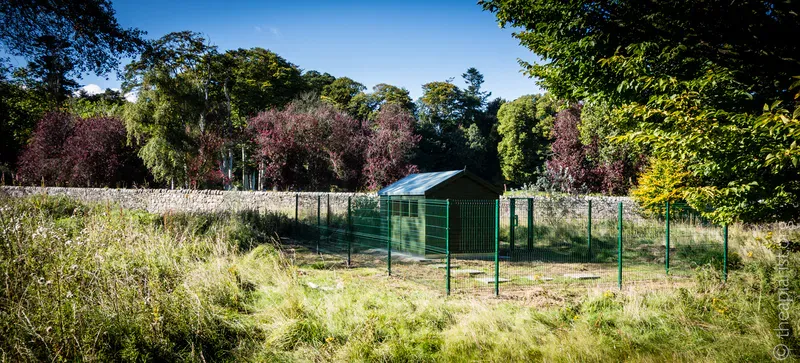Apiaries

Last Sunday I attended the opening of the Fife Beekeepers Association new teaching apiary near St. Monans. It was a lovely sunny day, with a gusty north-easterly blowing in off the sea keeping the temperature down and making the gazebo a bit of a handful.
The apiary is very well-organised, with stands arranged in a zigzag formation to reduce drifting, and with ample space around the hives — at least currently, before the proliferation of nucs when swarm control is needed — for trainees and their mentors. The stands are on slabbed bases, surrounded by neatly mown grass, with a few hundred native hedging plants heeled in for autumn planting.
There's a classroom overlooking the apiary and the inevitable shipping containers for secure storage and — in the fullness of time — a honey extraction room. Also nearing completion are toilets and a shower … about the only things missing are a jacuzzi and gym.

As apiaries go, it's closer to The Ritz than the Travelodge … and I stayed at one of these 25 times last year so should know (and it wasn't The Ritz).
All of this apiary-goodness was made possible with a National Lottery grant and a lot of hard work, in a short time, by the Fife BKA committee and members. Together with the new teaching facilities, the association has implemented a year-long training programme to help beginners both start beekeeping, and continue as beekeepers the following year having successfully overwintered their colonies {{1}}.
Although I said I 'attended' the event, I was honoured to have been invited to cut the ribbon, so had prepared a few words on apiaries and their importance to beekeepers. In the end, I restricted myself to a brief anecdote and well-deserved congratulations, delivered while standing in the wind on a wobbly chair.
I've been beekeeping long enough to know it's unwise to keep beekeepers and cakes separated for longer than absolutely necessary.
I didn't want to be trampled underfoot in the stampede.
Having jotted down a few thoughts on apiaries for the event, I thought I'd elaborate on them here while still fresh in my mind.
Apiary
The word apiary is derived from the Latin 'apiārium' which is a concatenation of 'Apis', meaning bee, and '‑ārium' which means ‘a place for’.
So, an apiary is a place where bees are kept, or a bee-house.
In the UK, the term bee-house (or bee shed) is often used to mean a building within which hives are located. I've written extensively about these as I used them for almost a decade.

For the purpose of this post, I'm talking about an outdoor space in which bees are kept.
As such, an apiary can be anything from a neglected corner of a field, to something very much grander.
But, within reason, whether basic or deluxe, what matters is what goes on in the apiary. This is where beekeeping experiences are, er, experienced. Where mistakes are made, lessons are learnt, and victories — however minor — enjoyed.
For most beginners (at least those that receive formal training) the association apiary is where they will see their first queen, and first queen cell. It's where they'll probably receive their first sting, and get even more bamboozled by the Tommy Cooper-esque 'Bottle, glass, glass, bottle' box-shuffling of the Pagden artificial swarm.
These are all important formative events in becoming a beekeeper.
Why not become a sponsor?
Sponsors receive weekly posts on bees and beekeeping, at least 50% of which are for sponsors only. Sponsorship costs less than a coffee and a slice of flapjack a month … or less for an annual membership.